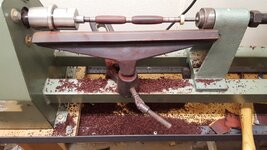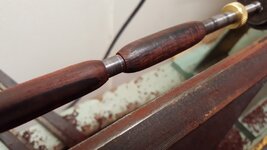Sammy-2016
Member
Hi all,
Tonight I just turned my first 2 pen blanks.
One is hard wood (Violet Black Indian Rosewood) & the other is softer wood which looks like Mahogany.
With both, I had a challenge:
I tightened the knurled nut by hand as much I could.
When first starting from the square blank, as soon as the gouge touches the turning blank, the blank stops. All the turning videos I have been watching, the turner tightens that nut by hand. I have to take pliers and give it a little to keep the square blank from stopping. It took me forever to get blanks round. An then in the spot at the beginning of the blank on the right hand, I got chatter every time I cut the spot (see picture please).
What I am doing wrong?
Please look at the attached pictures to see how I have the pieces on the mandrel.
Thank you
Sammy
Tonight I just turned my first 2 pen blanks.
One is hard wood (Violet Black Indian Rosewood) & the other is softer wood which looks like Mahogany.
With both, I had a challenge:
I tightened the knurled nut by hand as much I could.
When first starting from the square blank, as soon as the gouge touches the turning blank, the blank stops. All the turning videos I have been watching, the turner tightens that nut by hand. I have to take pliers and give it a little to keep the square blank from stopping. It took me forever to get blanks round. An then in the spot at the beginning of the blank on the right hand, I got chatter every time I cut the spot (see picture please).
What I am doing wrong?
Please look at the attached pictures to see how I have the pieces on the mandrel.
Thank you
Sammy
Attachments
Last edited:


